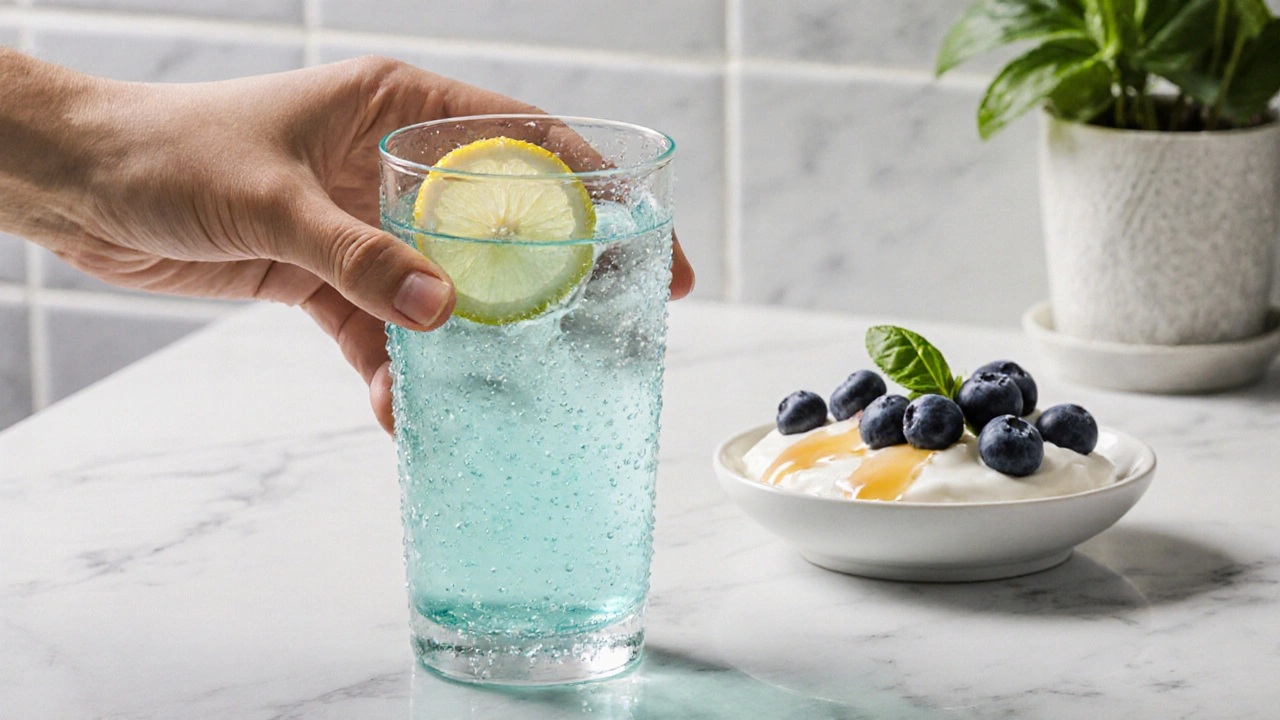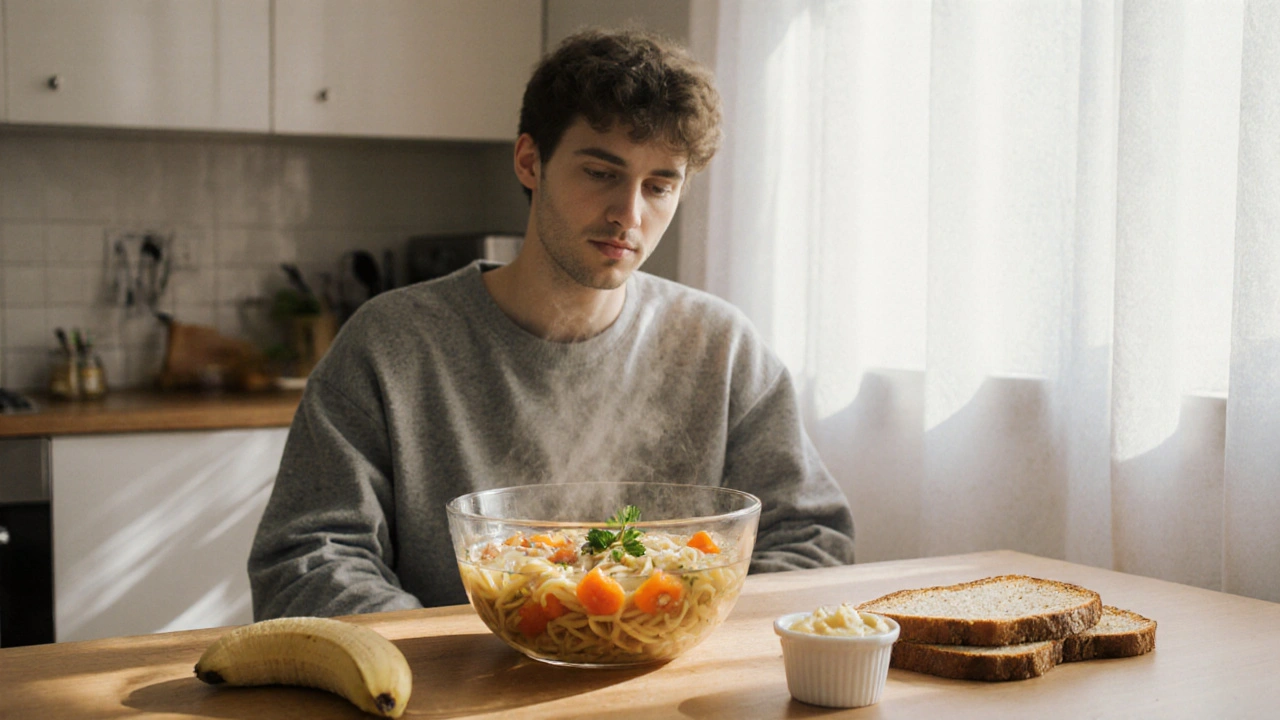Gastroenteritis Recovery Diet Planner
Track your recovery journey through the recommended gastroenteritis diet steps.
Replace fluids with clear liquids and oral rehydration solutions every hour.
Start with bananas, rice, applesauce, and toast after keeping fluids down.
Add low-fat proteins, soft vegetables, and gentle carbs.
Incorporate probiotic-rich foods like yogurt or kefir.
Avoid caffeine, dairy (except probiotic yogurts), spicy and high-fiber items.
Recovery Progress
Complete each step to track your recovery progress.
When a bout of Gastroenteritis is a sharp inflammation of the stomach and intestines that usually causes vomiting, diarrhoea and stomach cramps, the last thing you want to think about is food. Yet the right gastroenteritis diet can speed up recovery, keep dehydration at bay and restore the gut’s normal rhythm.
Quick Takeaways
- Start with clear fluids and oral rehydration solutions every hour.
- Introduce the BRAT diet (bananas, rice, applesauce, toast) after you can keep fluids down.
- Gradually add low‑fat proteins, soft vegetables and probiotic‑rich foods.
- Avoid caffeine, dairy (except probiotic yogurts), spicy and high‑fiber items for the first 48‑72hours.
- Follow a simple 3‑day sample plan to get back to normal meals.
Why Nutrition Is a Game‑Changer
The gut does more than just digest food; it’s a key player in the immune system and in balancing water and electrolytes. When dehydration a loss of body water that can quickly become dangerous if fluids aren’t replaced sets in, the body diverts energy away from healing. Proper nutrition supplies the fuel your cells need to rebuild the intestinal lining, while specific nutrients (like zinc and vitaminC) support immune function.
Step1: Hydration Above All
Before you even think about solid food, replace the fluids you’ve lost. Plain water is good, but a balanced oral rehydration solution (ORS) is better because it adds electrolytes minerals such as sodium and potassium that help the body retain water and prevent cramping.
Make your own ORS by mixing ½tsp of salt and 6tsp of sugar into 1L of clean water. Sip slowly every 5‑10minutes. If you can tolerate it, add a splash of 100% fruit juice for a bit of taste and extra potassium.
Step2: The Classic BRAT Diet
The BRAT diet has long been the go‑to for a gentle re‑introduction of solids. Each component is low in fat, easy to digest and provides a modest amount of carbohydrates to give you energy.
| Food | Why It Helps | Typical Portion |
|---|---|---|
| Bananas | Rich in potassium, helps replenish electrolytes | ½medium banana |
| Rice (white) | Starchy, bland, provides quick carbs | ¼cup cooked |
| Applesauce | Gentle source of pectin, may reduce diarrhoea | ¼cup |
| Toast (white bread) | Low‑fiber, easy on the stomach | 1slice |
Start with small portions-maybe a tablespoon of each-and see how your stomach reacts. If you can keep these down for a few hours, you can increase the quantity.

Step3: Modified Recovery Menu
After 24‑48hours of tolerating BRAT foods, you can broaden the menu. Aim for low‑fat proteins, soft cooked vegetables and gentle carbs. Here’s a quick checklist:
- Proteins: boiled chicken breast, scrambled eggs (no butter), tofu.
- Carbs: plain boiled potatoes, oatmeal made with water, soft pasta.
- Veggies: carrots, zucchini, peeled cucumber-cooked until soft.
- Fats: a drizzle of olive oil (just a teaspoon) to aid nutrient absorption.
Keep seasoning minimal-think a pinch of salt and a dash of fresh herbs. Spices, especially hot ones, can irritate the inflamed gut.
Smart Snacks & Probiotics
Restoring healthy gut bacteria speeds up recovery. Probiotic live microorganisms that, when consumed in adequate amounts, confer a health benefit on the host foods are a gentle way to do this.
- Yogurt a fermented dairy product loaded with Lactobacillus strains-choose plain, low‑sugar varieties. If dairy feels heavy, try a plant‑based kefir.
- Fermented vegetables like mild sauerkraut (rinse to reduce salt) or kimchi-use in tiny amounts.
- A probiotic supplement (10‑20billion CFU) if you’re unsure about food sources.
Introduce these after you’re comfortably eating solid meals. A small spoonful of yogurt after lunch can be enough.
Foods & Drinks to Steer Clear Of
Even if you feel hungry, some items can set you back:
- Caffeinated drinks (coffee, tea, energy drinks) - they act as diuretics.
- Alcohol - worsens dehydration and irritates the gut lining.
- Full‑fat dairy (milk, cheese) - hard to digest when the stomach is still sensitive.
- Spicy, acidic or heavily seasoned foods - can trigger cramping.
- High‑fiber raw fruits/vegetables (berries, broccoli, corn) - increase stool bulk too soon.
Putting It All Together: A Sample 3‑Day Plan
Below is a practical schedule. Adjust portions based on your appetite.
- Day1 - Rehydrate & Gentle Solids
- Morning: 200ml ORS, then small sip of apple juice.
- Mid‑morning: ¼cup applesauce + ½banana.
- Lunch: ¼cup white rice + ¼cup broth.
- Afternoon: 200ml ORS.
- Dinner: ¼cup rice + 1 slice toast.
- Day2 - Expand Carbs & Add Protein
- Breakfast: Oatmeal (½cup) made with water, topped with a few banana slices.
- Snack: Plain yogurt (½cup).
- Lunch: Boiled chicken (2oz) + soft carrots (¼cup).
- Snack: Small handful of peeled cucumber sticks.
- Dinner: Mashed potato (½cup) + scrambled egg (1egg).
- Day3 - Return to Normal Meals
- Breakfast: Whole‑grain toast with a thin spread of avocado.
- Snack: A banana and a cup of herbal tea (no caffeine).
- Lunch: Grilled fish (3oz) + boiled zucchini.
- Snack: Yogurt with a drizzle of honey.
- Dinner: Pasta with a light tomato sauce and a sprinkle of Parmesan.
Listen to your body. If any food triggers nausea or loose stools, pull back to the previous, more gentle step.
Common Questions About Post‑Gastroenteritis Nutrition

Frequently Asked Questions
Can I drink coffee once I feel better?
It’s best to wait at least 48hours after symptoms stop. Coffee can irritate the stomach lining and act as a diuretic, increasing the risk of dehydration.
Is it safe to take over‑the‑counter anti‑diarrheal meds while following this diet?
Only if a doctor advises it. Most cases of gastroenteritis resolve with fluids and gentle foods; stopping the gut’s natural purge can prolong the infection.
How long should I stay on the BRAT diet?
Typically 24‑48hours, or until you can tolerate a broader range of soft foods without nausea or loose stools.
Do probiotics actually speed up recovery?
Research shows that specific strains (e.g., Lactobacillus rhamnosus GG) can reduce diarrhoea duration by about one day in mild cases.
Should I avoid all dairy?
Most full‑fat dairy can be heavy, but low‑fat yogurt or kefir provides beneficial probiotics and can be re‑introduced early, provided it doesn’t upset your stomach.
Recovery from gastroenteritis isn’t just about stopping the vomiting and diarrhoea; it’s about giving your gut the right fuel to rebuild. By prioritising hydration, easing into the BRAT diet, adding gentle proteins, and eventually layering in probiotic‑rich foods, you’ll be back to your normal meals faster and with fewer setbacks.


Kayla Charles
September 29, 2025 AT 20:20When you’re battling gastroenteritis, the first thing to remember is that your gut needs gentle, consistent care.
Hydration is the foundation, so sipping oral rehydration solution every few minutes can make a huge difference.
Once you can keep fluids down, the BRAT diet becomes a safe stepping stone because bananas, rice, applesauce, and toast are low‑fat and easy on the stomach.
Don’t rush the process; give each food a few hours to see how your body reacts before increasing the portion.
After 24‑48 hours of tolerating BRAT foods, you can start to broaden the menu with soft proteins like boiled chicken or scrambled eggs.
Plain boiled potatoes, oatmeal made with water, and soft‑cooked carrots are excellent carbohydrate and veggie options that won’t irritate the lining.
Adding a teaspoon of olive oil can help your body absorb fat‑soluble vitamins without overwhelming the digestive system.
Probiotic‑rich foods such as plain yogurt or kefir help re‑populate healthy gut bacteria, accelerating recovery.
If dairy feels heavy, try a plant‑based kefir or a small spoonful of fermented vegetables.
Remember to avoid caffeine, alcohol, and spicy foods for at least the first two days because they can trigger cramps and increase fluid loss.
High‑fiber raw fruits and vegetables should also be held back until you’re fully comfortable with softer foods.
Electrolyte balance is critical; consider adding a pinch of salt to your water or using a commercial ORS mix to replace sodium and potassium.
Zinc and vitamin C can support immune function, so a modest supplement or a splash of orange juice (if tolerated) can be beneficial.
Listen to your body’s signals: if nausea returns, step back to the previous, more gentle stage.
Maintain a regular eating schedule to give your gut a predictable rhythm, which promotes healing.
Stay upright after meals for at least 30 minutes to aid digestion and prevent reflux.
Finally, celebrate small milestones – each successful sip or bite is a sign that your gut is on the mend.
Paul Hill II
September 29, 2025 AT 22:20Starting with clear fluids is crucial, and the ORS recipe they gave-half a teaspoon of salt and six teaspoons of sugar per liter-is simple to make at home.
Once you can keep that down, the BRAT foods give you a gentle source of carbs and potassium without overloading your stomach.
From there, introducing low‑fat protein and soft veggies helps rebuild muscle and provides needed vitamins.
It’s also smart to add a little probiotic yogurt once you feel solid foods are staying down, as it can shorten the diarrhoea phase.
Stephanie Colony
September 30, 2025 AT 00:20Your diet plan reads like a textbook, not a kitchen.
Abigail Lynch
September 30, 2025 AT 02:20Honestly, after a night of gut turmoil, the thought of anything other than clear broth feels like a betrayal.
David McClone
September 30, 2025 AT 04:20Oh great, another "look at this perfect plan" post-because I definitely needed a step‑by‑step from a stranger who probably never vomited.
Jessica Romero
September 30, 2025 AT 06:20In terms of clinical nutrition, the protocol aligns with evidence‑based recommendations: prioritize isotonic fluid replacement, then employ low‑residue carbohydrates, followed by incremental protein re‑introduction and finally probiotic colonization.
That said, the layperson might find the bullet‑point format more user‑friendly than the dense jargon sprinkled throughout.
Michele Radford
September 30, 2025 AT 08:20Anyone who thinks a banana can fix a gut infection clearly never dealt with real illness.
Mangal DUTT Sharma
September 30, 2025 AT 09:20Hey, I get that it can feel frustrating, but the BRAT diet isn’t a myth-it’s a clinically tested approach.
🙂 Staying hydrated and giving the gut a break with bland foods actually speeds up recovery, not slows it down.
Gracee Taylor
September 30, 2025 AT 10:20Let’s keep the conversation respectful; while sarcasm can be funny, the goal here is to share useful tips for people feeling miserable.
Jonathan Alvarenga
September 30, 2025 AT 12:20The post glosses over the fact that many patients have comorbidities that make this "one size fits all" approach dangerous.
For example, someone with chronic kidney disease cannot just drink any ORS solution without risking electrolyte imbalance.
Moreover, the recommendation to avoid dairy except for probiotic yogurts disregards lactose‑intolerant individuals who may react badly to any dairy whatsoever.
In practice, clinicians must tailor fluid and nutrient plans to each patient's medical history, lab values, and tolerance levels.
Simply copying the sample 3‑day plan without medical guidance can lead to inadequate caloric intake or, worse, re‑hydration injury.
Jim McDermott
September 30, 2025 AT 14:20i think the article is good but maybe add some tips for kids since they cant drink alot at once.
Naomi Ho
September 30, 2025 AT 16:20Make sure you sip fluids often keep the ORS mixture ready avoid caffeine and spicy foods those are the main culprits
Christopher Stanford
September 30, 2025 AT 18:20the plan is too generic many people need more intensve care not just banannas and toast